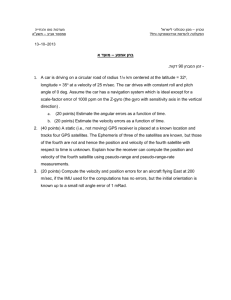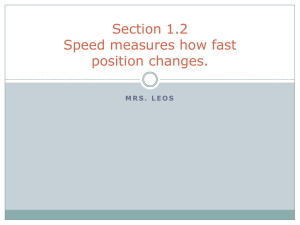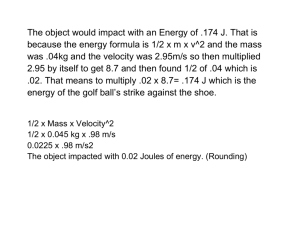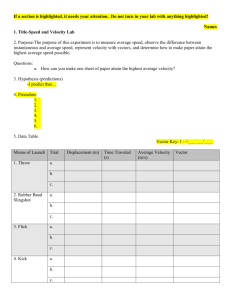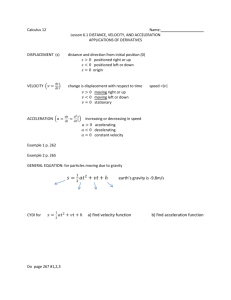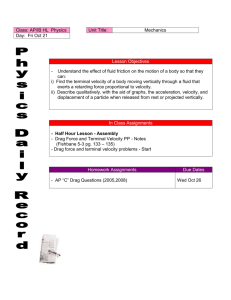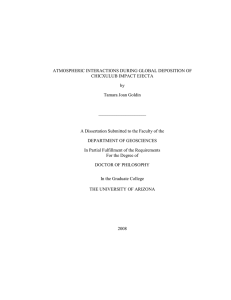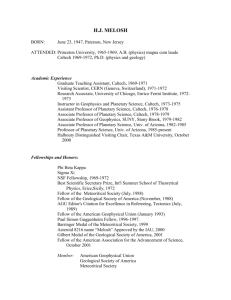jgre20465-sup-0001-supplementary
advertisement
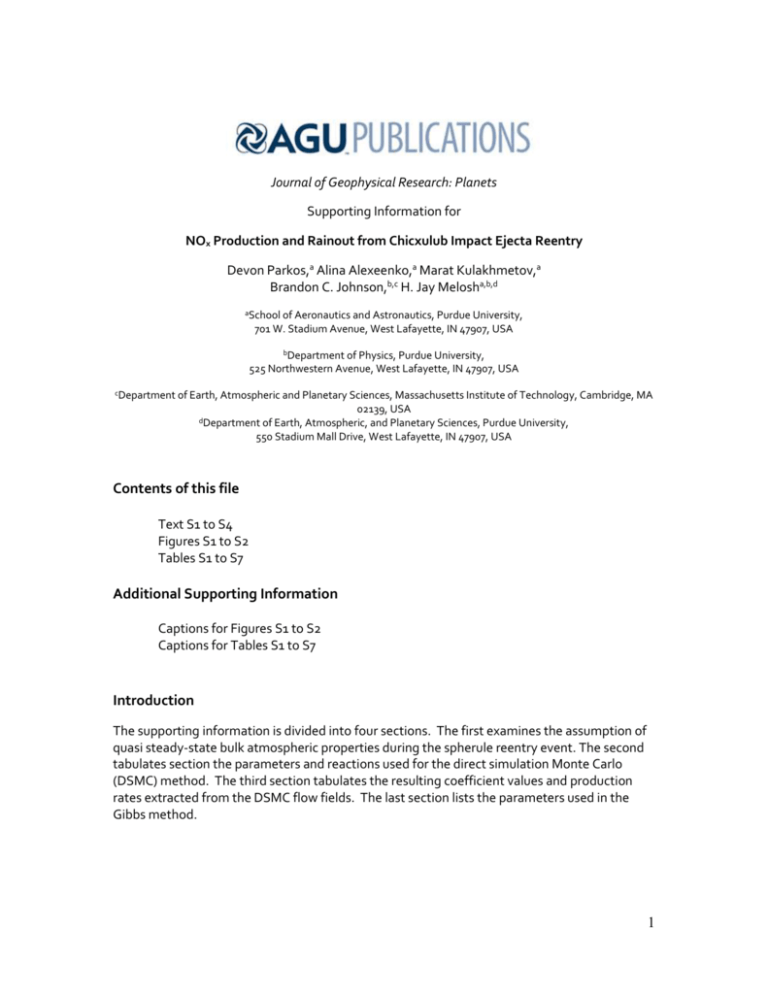
Journal of Geophysical Research: Planets Supporting Information for NOx Production and Rainout from Chicxulub Impact Ejecta Reentry Devon Parkos,a Alina Alexeenko,a Marat Kulakhmetov,a Brandon C. Johnson,b,c H. Jay Melosha,b,d aSchool of Aeronautics and Astronautics, Purdue University, 701 W. Stadium Avenue, West Lafayette, IN 47907, USA bDepartment of Physics, Purdue University, 525 Northwestern Avenue, West Lafayette, IN 47907, USA cDepartment of Earth, Atmospheric and Planetary Sciences, Massachusetts Institute of Technology, Cambridge, MA 02139, USA dDepartment of Earth, Atmospheric, and Planetary Sciences, Purdue University, 550 Stadium Mall Drive, West Lafayette, IN 47907, USA Contents of this file Text S1 to S4 Figures S1 to S2 Tables S1 to S7 Additional Supporting Information Captions for Figures S1 to S2 Captions for Tables S1 to S7 Introduction The supporting information is divided into four sections. The first examines the assumption of quasi steady-state bulk atmospheric properties during the spherule reentry event. The second tabulates section the parameters and reactions used for the direct simulation Monte Carlo (DSMC) method. The third section tabulates the resulting coefficient values and production rates extracted from the DSMC flow fields. The last section lists the parameters used in the Gibbs method. 1 Text S1. Our work assumes that the spherules reenter into an atmosphere with quasi-steady bulk properties, namely time-constant bulk temperature and bulk density profiles. However, this is not precisely what will occur. The spherules at the beginning of the event will encounter an unsteady atmosphere that is gradually compressed and heated. Furthermore, the spherules at the conclusion of the event will encounter an expanding and cooling atmosphere. However, results from existing work [Goldin and Melosh, 2009] suggest that the majority of the spherules, over ~85%, will experience near steady-state conditions (Fig. S1). Next, we examined the sensitivity of NO production to the ambient bulk temperature and found that the NO rate changes by less than 20% when the temperature is perturbed by 30% from our chosen value (Fig. S2). Figure S1B indicates that roughly 5 minutes after the start of the reentry event the ambient temperature reaches within 30% of its final value. Additionally, the mass flux profile in Fig. S1A shows that less than 4% of the ejecta mass reenters within the first 5 minutes of the event. Therefore, we conclude that approximately 85% of the spherules will produce steady-state NO emissions, and an additional 11% of the spherules will experience near steady-state emissions. For the sake of simplicity in our analysis, we neglect the effect of a transient atmosphere. It is worth noting that the DSMC cases will also be sensitive to ambient bulk density, however, decreases in ambient density would merely shift our predicted NO production to lower altitudes. The spherules would retaining their velocity until reaching lower altitudes due to the reduced drag force. 2 Max Temperature [K] 2 Spherule Mass Flux [kg/m /min] 5000 0.2 0.1 0 0 10 20 30 40 50 60 4000 3000 2000 1000 0 0 5 Time [minutes] 10 15 20 Time [minutes] NO Production Rate [molecules/s] Figure S1. (A) Approximated globally averaged flux of spherules determined using existing data [Melosh et al., 1990] compared to the flux assumed by Goldin and Melosh [2009]. (B) Maximum temperature in the atmosphere during the spherule reentry event reaches steady-state within 10 minutes and ~70% of its final value within 5 minutes. 1013 10 12 10 11 1010 109 10 8 0 0.2 0.4 0.6 0.8 1 1.2 1.4 Tambient/Tnominal Figure S2. NO production rate sensitivity to ambient bulk temperature at the 113.6 km altitude, 7.3 km/s spherule velocity DSMC. All temperature modes are assumed to be in thermochemical equilibrium in the freestream. 3 Text S2. Spherule reentry is calculated at 16 conditions, where altitudes ranged between 66 and 134 km and spherule velocities ranged between 5.5 and 11.5 km/s. The simulated velocities are 5.5, 7.3, 9.7, and 11.5 km/s are chosen as collocation points for the 5 to 12 km/s range. Spherules above the 12 km/s ejection velocity will escape Earth’s gravity. Spherules entering below 5 km/s do not cause significant N2 dissociation, which is essential for NO formation. At the free-stream velocities of 5 km/s, less than 0.1% of particle collisions near the flow stagnation point have energies above 10 eV. The incoming flow is in thermochemical equilibrium at the elevated temperature conditions specified in the main document. Altitude [km] Temperature [K] Number Density [molecules/m3 ] 134.45 3698 113.60 Mole Fractions N2 O2 NO N O 5.00E+19 0.526 4.15E-6 3.86E-4 0.100 0.374 3285 8.30E+19 0.641 6.86E-5 1.14E-3 9.39E-3 0.348 86.40 2225 3.17E+20 0.741 0.132 1.14E-2 1.52E-6 0.116 65.56 534 4.85E+21 0.789 0.211 2.53E-9 3.59E-42 8.96E-21 Table S1. Free-stream temperature and density information for each altitude used for generating the drag and production response surfaces. Mole Fractions Altitude [km] Temperature [K] Number Density [molecules/m3 ] 134.45 464 1.14E+17 0.617 113.60 252 1.10E+18 86.40 208 65.56 233 N2 O2 NO N O 0.383 1.45E-10 4.80E-47 3.06E-22 0.727 0.273 0.00E-0 4.11E-92 2.69E-46 1.11E+20 0.784 0.206 4.44E-19 9.49E-114 3.36E-58 2.26E+21 0.781 0.209 1.34E-20 9.83E-102 3.63E-52 Table S2. Free-stream temperature and density information for the modern day atmosphere, based on the MSIS-E-90 Atmosphere Model. 4 Reaction Ea A b Ea,r Ar br O + N2 O + N + N 1.56E-18 4.09E-11 -1 5.24E-19 2.49E-12 -1 N + N2 N + N + N 1.56E-18 4.09E-11 -1 1.56E-18 2.49E-12 -1 O2 + N2 O2 + N + N 1.56E-18 4.09E-11 -1 1.56E-18 2.49E-12 -1 N2 + N2 N2 + N + N 1.56E-18 4.09E-11 -1 1.56E-18 2.49E-12 -1 NO + N2 NO + N + N 1.56E-18 4.09E-11 -1 1.56E-18 2.49E-12 -1 O + NO O + N + O 1.04E-18 6.79E-12 -1 2.69E-19 5.81E-12 -1 N + NO N + N + O 1.04E-18 6.79E-12 -1 1.00E-27 5.81E-12 -1 O2 +NOO2 +N +O 1.04E-18 6.79E-12 -1 1.04E-18 5.81E-12 -1 N2 +NON2 +N +O 1.04E-18 6.79E-12 -1 1.04E-18 5.81E-12 -1 NO+NONO+N +O 1.04E-18 6.79E-12 -1 1.04E-18 5.81E-12 -1 O+O2 O+O+O 8.20E-19 1.50E-11 -1 8.20E-19 1.49E-14 -0.5 N + O2 N + O + O 8.20E-19 1.50E-11 -1 1.00E-27 1.49E-14 -0.5 O2 +O2 O2 +O+O 8.20E-19 1.50E-11 -1 8.20E-19 1.49E-14 -0.5 N2 +O2 N2 +O+O 8.20E-19 1.50E-11 -1 8.20E-19 1.49E-14 -0.5 NO+O2 NO+O+O 8.20E-19 1.50E-11 -1 8.20E-19 1.49E-14 -0.5 O+N2 NO+N 5.24E-19 1.22E-18 0.5 5.24E-19 0.00E+00 0 O+NOO2 +N 2.69E-19 4.95E-19 0.5 2.69E-19 0.00E+00 0 N+NON2 +O 0.00E+00 2.66E-19 0.5 0.00E+00 0.00E+00 0 N+O2 NO+O 0.00E+00 1.58E-20 1 0.00E+00 0.00E+00 0 Table S3. Reaction rate coefficients for the modified Arrhenius equation [Hassan and Hash, 1993; Hash et al., 1994]. 5 Altitude [km] Particles Per Cell Time Step [s] Sampled Steps Samples Per Cell 134.45 12.9 1.00E-09 1,500,000 5.956E6 113.60 10.7 1.00E-09 1,500,000 8.978E6 86.40 7.30 1.00E-10 1,500,000 1.153E7 65.56 6.51 4.00E-11 1,500,000 1.649E7 Table S4. Simulated particles per cell and sampling information for each altitude used for generating the drag and production response surfaces. Text S3. The following section details the values extracted from the DSMC flow fields. The drag coefficient was obtained by integration of surface pressure normal and shear forces acting on the spherule geometry. The production rate is obtained by integration of chemical fluxes at the domain boundary. Spherule Drag Coefficient Altitude [km] 5.5 km/s Velocity 7.3 km/s Velocity 9.7 km/s Velocity 11.5 km/s Velocity 134.45 1.81 1.71 1.65 1.62 113.60 1.57 1.49 1.44 1.42 86.40 1.83 1.76 1.71 1.70 65.56 1.69 1.72 1.77 1.75 Table S5. Drag coefficient determined from integration of surface pressure extracted from DSMC simulations. 6 NO Production Rate [molecules/s] Altitude [km] 5.5 km/s Velocity 7.3 km/s Velocity 9.7 km/s Velocity 11.5 km/s Velocity 134.45 2.57E+10 4.67E+11 1.27E+12 1.74E+12 113.60 8.65E+10 1.49E+12 1.26E+13 2.86E+13 86.40 1.96E+11 9.37E+12 9.63E+13 2.51E+14 65.56 7.43E+10 2.25E+13 1.26E+15 1.31E+16 Table S6. NO production rate determined from integration of flow field fluxes extracted from DSMC simulations. Text S4. The following section details the parameters used in the Gibbs method, which allows calculation of the atmospheric composition assuming equilibrium is reached. Species M r [g/mol] [K] v e Electronic Heat of Formation [K] [K] Degeneracies [kJ/mol] 5, 3, 1, 5 246.79 4, 6, 4, 6 470.82 1, 2 0 2, 2, 2 89.775 3, 2 0 228 O 15.9994 - - - 326 22850 27659 N 14.0067 - - - 27672 41492 N2 28.0134 2.90 2 3390 NO 30.0061 2.44 1 2740 O2 31.9988 2.10 2 2270 99600 174 63300 11400 Table S7. Parameters used for Gibbs method to find equilibrium atmospheric composition. 7

